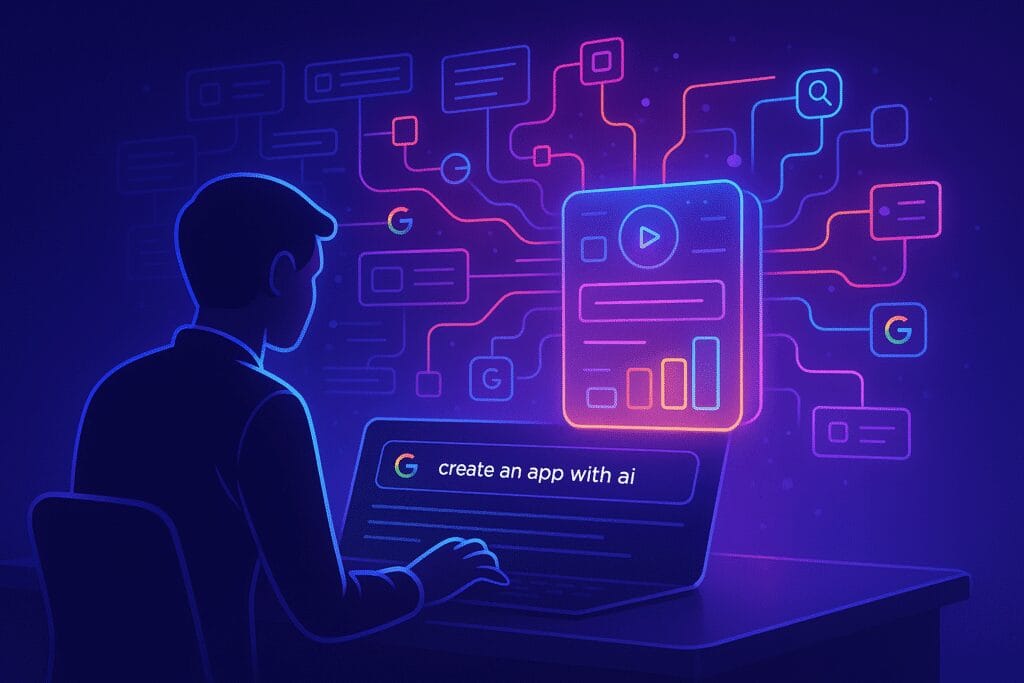The Dawn of the “Vibe Coder”
The world of software development is in the midst of a seismic shift, a fundamental reordering of how human ideas are translated into functional applications. For decades, this translation required a specialized, often arcane skill: the ability to write code. But a new movement is gathering force, one that replaces the rigid syntax of programming languages with the fluid, intuitive power of natural language. This is the era of the “vibe coder,” a term popularized by OpenAI’s Andrej Karpathy that describes a new class of creator who builds software not by writing explicit, line-by-line instructions, but by expressing intent, goals, and a general “vibe”.1
This trend is more than just a new feature; it represents a paradigm shift aimed at radically lowering the barrier to digital creation, potentially unlocking the innovative capacity of millions who have ideas but lack formal programming skills.2 Into this dynamic and disruptive landscape steps Google, with its latest and most ambitious entry into the field: a new experimental tool from Google Labs called Opal.
Announced in late July 2025, Google Opal is designed to empower “creators, innovators, and doers” by transforming simple, plain-English prompts into powerful, shareable “mini-apps”.1 It is Google’s strategic and highly visible bet on this emerging category. The significance of this moment is not lost on the market. The excitement surrounding no-code and “vibe coding” platforms has ignited a firestorm of investment and user adoption. Last week, Lovable, an eight-month-old Swedish AI startup focused on no-code app creation, became a unicorn after a $200 million Series A funding round valued the company at $1.8 billion. Another player, Cursor, developed by a small team at Anysphere, reached an impressive $100 million in annual recurring revenue (ARR) in January 2025 and doubled that figure by March.1 This influx of capital and rapid market validation makes one thing clear: “vibe coding” is not a fleeting fad.It is a highly funded, fiercely competitive new frontier in software creation.
With the help of Google’s huge resources and AI expertise, tools like Opal are becoming available, which is a sign of a major change. It seems to show that natural language is moving from being a feature—something that is used for things like search questions and chatting with chatbots—to becoming the next main way that people create things. This is a change as basic as the move from the command line to the graphical user interface (GUI). Every big wave of computing in history, from mainframes to PCs to the web and mobile devices, has made it easier for people to use computers. The primary bottleneck for software creation has consistently been the complexity of programming languages. Generative AI, for the first time in history, provides an engine robust enough to translate ambiguous, contextual human language into the structured, logical instructions that computers require. Google’s own announcement underscores this, framing Opal as part of a “long-term bet on natural language interfaces as the future of software development”.1 Therefore, Opal is not just another experiment in no-code development; it is an early, critical experiment in a post-code future, where the most valuable skill is no longer mastering syntax but articulating intent with clarity and logic.
: Why “Opal” Are Discussing?
Then there is Opal, the marketing planning tool. This is a sophisticated business software solution utilised by large worldwide brands like Starbucks, Target, and Microsoft to graphically collaborate on and design their marketing campaigns.
Further complicated situations are:
Opal Security:
OPAL Fuels (NASDAQ:OPAL):
Opal (OPAL) Cryptocurrency:
For the remainder of this research, it is vital to be unambiguously clear: this report is solely about Google’s experimental AI mini-app builder, a product of Google Labs, aimed to construct software using natural language.
This broad name collision creates an important strategic dilemma. Google’s use of a generic, extensively used term like “Opal” for a high-profile experimental product is a peculiar, and probably incorrect, branding move. Typically, a firm of Google’s prominence debuts key products with distinctive, memorable, and easily searchable names to develop brand equity and enable organic discovery. The name “Opal” actively works against this purpose. Any user looking for “Opal” or “Opal reviews” is instantly greeted with a confused mélange of results spanning productivity apps, corporate software, energy stocks, and cryptocurrency. 7 This dilutes the product’s signal and hampers the ability of its target audience to access relevant information. This contrasts strongly with more unique Google branding like “Gemini” or “Bard.” The choice may represent the tool’s “experimental” status, signifying a reduced commitment in long-term branding, or it might just be an uncommon slip in an increasingly cluttered digital world.
Deconstructing Google Opal: From Simple Prompt to Shared Mini-App
At its heart, Google Opal is designed around an elegant and intentionally straightforward user journey. This journey can be broken down into a simple, three-step core loop: Describe, Create, and Share.4
- Describe: The process begins with the most basic of interfaces: a text box. Here, the user types a natural language prompt that expresses the intent of the application they wish to build. This is the “vibe-coding” aspect in its purest form, where the focus is on conversational intent rather than technical specification. A user might start with a prompt like, “Create a high quality YouTube thumbnail generator based off of my YouTube videos,” or “Build an app that finds 5-10 high-potential YouTube video ideas for my channel by checking Google Trends”.
2. Create: This is where Opal’s fundamental technology activates.
3. Share: Once the user is pleased with the app’s functioning, they may quickly publish it with a single click. Opal produces a unique URL that may be shared with others. Anyone with a Google account may then access and utilise the newly developed mini-app, allowing simple collaboration, testing, and dissemination.
The Power of the Visual Editor
What elevates Opal beyond a simple prompt-to-app generator is its interactive visual editor. This is the key component that provides users with fine-grained control without requiring them to write code.6 The platform supports a dual interaction model: users can continue to issue conversational commands to modify the app, or they can engage in direct visual manipulation.
Within the editor, each node in the workflow diagram is clickable and editable
The Engine Under the Hood
Opal is not a standalone AI; it is a sophisticated front-end that orchestrates a suite of Google’s most powerful and advanced generative AI models.19 While Google has not specified every model used, analysis and reports indicate the integration of:
- Gemini 2.5 Pro: Google’s flagship large language model, used for the core logic, reasoning, text generation, and code assistance that underpins the app creation process.19
- Veo 3: Google’s state-of-the-art video generation model, enabling mini-apps that can create video content.20
- Imagen: Google’s advanced text-to-image model, used for generating visual assets and images within the apps.20
The Promise: Why Silicon Valley is Buzzing About Democratized Development
The enthusiasm around Google Opal and the larger “vibe coding” movement is evident, and with good cause. The technology has the potential to address numerous long-standing difficulties in the IT sector, which is why venture capitalists are investing hundreds of millions of dollars in it and tech executives are keeping a close eye on it. The promise of this new era can be understood through three key pillars.
First and foremost is the democratization of creation. The central vision is to empower a vast new population of “citizen developers.” These are the subject-matter experts, the creative professionals, the small business owners, and the departmental managers who have brilliant ideas for digital tools but have historically been locked out of the creation process by the high barrier of programming. Opal aims to give these individuals the power to build their own solutions, transforming the landscape of who can create software.1
Second, dramatic acceleration of innovation.
Finally, Opal promises to solve frustrating pain points in large organizations: the internal tooling backlog. Across every enterprise, engineering teams are perpetually inundated with requests from other departments (marketing, sales, HR, finance) to build “simple” internal tools—custom dashboards, data entry forms, approval workflows, and reporting applications. While these tools are often critical for productivity, they are resource-intensive to build and maintain, pulling expensive engineering talent away from core, customer-facing product development. Opal and similar platforms promise to offload this burden by enabling the business units themselves to build the tools they need. The potential for productivity gains is enormous. Marketing teams could spin up apps to generate dozens of social media captions from a single blog post, sales teams could create tools to draft personalized follow-up emails, and research teams could build apps to summarize academic papers, all without ever filing a ticket with the IT department.
The Reality Check: A Hands-On Look at Opal’s Experimental State
While the promise of Opal is immense, it is essential to ground the excitement in the current reality of the product. Google has been very deliberate in branding Opal as “brand new and experimental,” launching it as a US-only public beta specifically to gather community feedback and refine the tool. This “experimental” label is not just a disclaimer; it is a crucial signal to manage user expectations about the platform’s stability and performance. Hands-on reviews from early testers have painted a clear picture of a tool that is powerful in concept but often buggy, frustrating, and unreliable in practice.
A litany of failures reported by users reveals a pattern of unpredictability. The most vivid example comes from a review by BetterStack, which attempted to build a seemingly straightforward traffic prediction app. The process devolved into a cascade of errors:
- First, the app produced a comically inaccurate, hand-drawn-style map instead of a real one.
- When prompted to use the Google Maps API for a precise image, the app then failed and demanded the user provide their own API key.
- After the user supplied their key, the app failed again, this time with a cryptic “Content Security Policy directive” error that effectively bricked the application, forcing the reviewer to give up in frustration.
This was not an isolated incident. Other reviewers have reported similarly inconsistent and unpredictable outputs, including an “AI Image Fail” where the image generation component simply did not work, and a movie summarizer app that “went wrong” without a clear explanation.28
Beyond these outright failures, early users have highlighted significant functional limitations. The built-in toolset is currently very sparse, limited to basic functions like web search and weather queries. For any other functionality, users must manually register external APIs, a process that is far from trivial for the non-technical audience Opal targets. The platform also lacks fundamental programming logic, such as the ability to automatically loop or iterate through a list of items, a shortcoming that quickly becomes a blocker for even simple data processing tasks.
The cumulative effect of these issues is a frustrating user experience. Reviewers have described a feeling of “false hope,” where the tool appears to be working perfectly until it suddenly and inexplicably fails at the final step. This has led to calls for “a more precise way to tweak the nodes” and, critically, for access to the underlying code for debugging purposes—a feature that runs counter to the tool’s no-code philosophy. Some have even concluded that without an API layer or the ability to embed the created apps into other websites, the tool is “kind of useless at the moment” for any serious application.
This state of affairs reveals a frustrating paradox at the heart of the current generation of “vibe coding” tools. The simplicity of the interface is designed to attract non-coders, yet the platform’s unreliability and opaque failure modes often require deep technical debugging skills that those very users lack . It must also become an expert-level debugger, capable of diagnosing its own failures and explaining them—and their solutions—in plain, accessible language. The current generation of tools is not there yet.
The Arena: Placing Opal in a Crowded Competitive Landscape
The Enterprise Incumbent: Microsoft Power Platform
The most direct and significant battle for Opal will be fought in the enterprise market, where it faces off against Microsoft’s formidable Power Platform. From the moment of its launch, industry analysts framed Opal as “Google’s answer to Power Platform + Copilot Studio”. Microsoft’s primary advantage is its deep, entrenched integration with the Office 365 and Dynamics 365 ecosystems. For the countless large organizations that run on Microsoft’s software stack, Power Platform is the natural, default choice for low-code application development and automation. It is a mature, feature-rich platform with established governance, security protocols, and enterprise-grade support. However, its complexity can be daunting, and its pricing model, which charges extra for “premium connectors” to essential data sources like SQL databases, can become prohibitively expensive at scale. In this context, Opal enters as a more agile, AI-native, and user-friendly alternative, but it currently lacks the enterprise readiness, security assurances, and robust feature set to seriously challenge Microsoft’s hold on its core customers.
The Workflow Automation Kings: Zapier & n8n
Another key comparison is with the established leaders in workflow automation, Zapier and n8n. It is crucial to distinguish their core purpose from Opal’s. Zapier and n8n are designed primarily to connect existing applications and automate the flow of data between them. For example, a user might create a “Zap” to automatically add a new email subscriber from a form to a Google Sheet. Opal, in contrast, is designed to
create new, standalone mini-applications from scratch.
Zapier’s dominant position comes from its massive library of over 6,000 pre-built app integrations, making it the de facto universal connector for the modern web. Its simplicity is a major draw, but its task-based pricing model can become extremely costly for businesses running high-volume or complex, multi-step workflows. n8n is a more powerful, developer-centric, and often open-source alternative that can be self-hosted, offering more granular control and flexibility for technical teams. While some commentators have sensationally positioned Opal as a potential “killer” of these tools , a more nuanced view is that they serve fundamentally different, though sometimes overlapping, use cases.
The Trojan Horse: Enterprise Adoption and the Peril of Shadow IT
For all its potential, Google Opal faces a monumental hurdle to widespread adoption within large organizations: the profound risk of “Shadow IT.” This term refers to the use of unauthorized hardware, software, or cloud services by employees without the knowledge or approval of the central IT department. The very features that make Opal so appealing to individual employees—its extreme ease of use, its current lack of a price barrier, and its simple link-based sharing—make it a potential nightmare for corporate security, compliance, and governance teams. Opal, in effect, acts as a powerful catalyst for the creation of unsanctioned and ungoverned applications.
The specific risks:
- Data Leakage and Exfiltration:
- Regulatory and Compliance Violations:
- Security Vulnerabilities:
Conclusion: The Future of Software, According to Google
Ultimately, whether Google Opal itself succeeds and graduates from Google Labs or is eventually sunsetted—a common fate for Google’s experimental projects, as cynical users are quick to point out 35—is almost secondary. Its launch is a powerful statement of intent. It represents a clear and unambiguous signal of Google’s long-term strategic direction: a massive, public bet that natural language is the definitive future of human-computer interaction for complex creation tasks.
The path forward for Opal, should it continue, will be dictated by the feedback from its initial beta phase. To move beyond a promising but flawed experiment, it will need to address the “beta blues” by drastically improving reliability, expanding its limited toolset, providing an “advanced mode” that offers greater transparency into its reasoning process, and eventually rolling out internationally with a mature, enterprise-ready governance model and a consumption-based pricing structure.
The rise of tools like Opal does not herald the obsolescence of the software developer. Rather, it signals an evolution and elevation of the role. As “citizen developers” begin to handle the creation of simple internal tools and prototypes, professional developers will be freed to focus on more complex and valuable challenges. Their work will shift from building routine CRUD applications to designing robust system architectures, managing and securing fleets of AI-generated systems, ensuring enterprise-grade performance and scalability, and building the core platforms and APIs that the rest of the organization will consume.
We are standing at the dawn of a new era of software development. The rigid line between the user and the creator is beginning to dissolve. Google Opal, in all its promising, powerful, and profoundly flawed glory, is one of the first and most important glimpses of that future. It is a future where the ability to build is limited not by one’s knowledge of a programming language, but by the clarity and logic of one’s thought.




Really great info can be found on site.